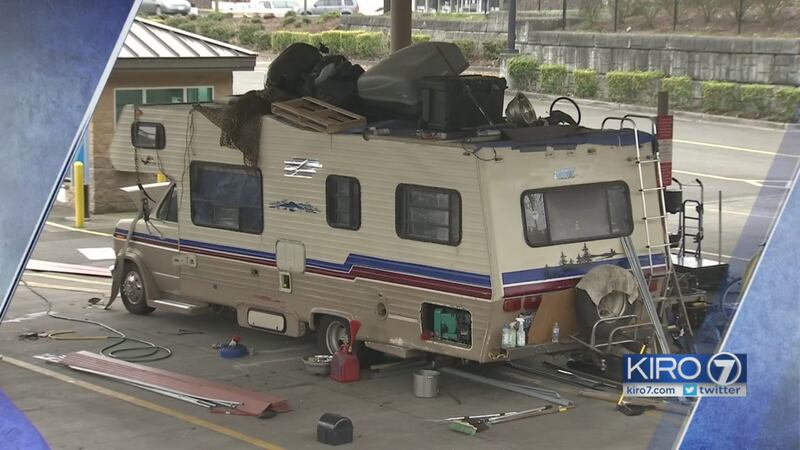More than 18 months after KIRO 7 first went along with a new Seattle task force focused on squatters and vacant property issues, numbers show that complaints are on the rise.
According to the city’s Department of Construction and Inspections, in 2015, there were 354 vacant building complaints. In 2016, the year the task force launched, there 419. In 2017, there were 439.
Most recently, neighbors have complained about squatters who have taken up residence in the parking lot of a closed Sam’s Club on Aurora Avenue. They said they’ve found garbage in the lot and also around the neighborhood.
“Condom wrappers, condoms, needle caps, needles, broken glass pipes and things of that nature,” neighbor Bliss Moore said. “It's not very cool. If they would just clean up their mess…. Then I wouldn’t feel so hesitant about having them in the ‘hood.'”
"The city launched this new task force. Why is this problem getting worse?" KIRO 7 reporter Linzi Sheldon asked Faith Lumsden, the city code compliance director.
"Well, we are seeing a lot of people breaking into vacant buildings seeking shelter," Lumsden said.
She said the city is growing and so is redevelopment.
Addressing problem properties can be like playing Whack-a-Mole.
“We are doing better at keeping vacant buildings from becoming really, really horrible,” she said. “We see it, we fix it, it shifts to some other building.”
Squatting isn't just against the law.
When KIRO 7 went along with the city's task force in 2016, police and fire officials explained the houses can be dangerous for first responders: some squatters have even set booby traps.
But the task force has had successes. Examples include a problematic Wallingford site owned by developer Robert Hardy that had several fires. A neighbor sent KIRO 7 a photo on Friday showing a brand new structure going up.
And after squatters moved into a foreclosed house on MLK Jr. Way South in South Seattle, the city cleaned it up, boarded it up, and sent bills to the mortgage company.
Changes in the city code last fall, Lumsden said, have been “very, very helpful.” One allows speedier demolition of sites with two unauthorized entries and a memo from first responders about the dangers.
The other enables the city to bill the site’s owner not just for securing the site with things like fencing and plywood, but also for cleaning up the outside. Garbage, Lumsden said, can be a signal to other squatters that a building is vacant.
“Now we can clean up the whole nuisance,” she said. “We don’t have to just board it up but leave a yard filled with trash and overgrown weeds.”
Lumsden only has two inspectors and they are not full-time.
“Do you need more inspectors?” KIRO 7 reporter Linzi Sheldon asked.
“I always need more inspectors,” she said. “I’m pretty sure I’m not supposed to say that on television but yes, indeed, we need more inspectors. Of course we do.”
“When you see the numbers going up, is that frustrating?” Sheldon asked.
“Is it better reporting [of problems]? Is it ever going to stop? I don't think so,” Lumsden said. “I think we’ll see this as long as Seattle keeps growing.”
She said the city is trying to work with developers and nonprofits to see if they can have tenants or caretakers in properties longer while permits are going through. This, she said, will reduce the time they are vacant and vulnerable to squatters.
Lumsden said the city is also considering increasing the minimum standards for securing a building—perhaps, she said, requiring owners to use sturdy plexiglass, which is very difficult for squatters to remove, as opposed to plywood.
She said anyone who currently owns a vacant home or building needs to understand the risks.
“People need to know that having a vacant property, especially a vacant house, is dangerous,” she said. “It’s going to—sooner or later—invite someone to break in.”
Scroll down to continue reading
More news from KIRO 7
- Saudi prince's visit may jam traffic in Puget Sound Friday
- Dad had girlfriend rape son with autism because he thought boy was gay
- Washington forgot to charge this fee and now wants drivers to pay up
- Seattle woman warns of potential new locksmith scam
- Vegans protest restaurant's serving of meat, owner carves deer leg in front window
Cox Media Group








